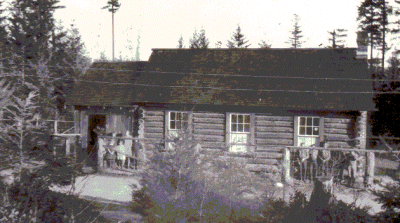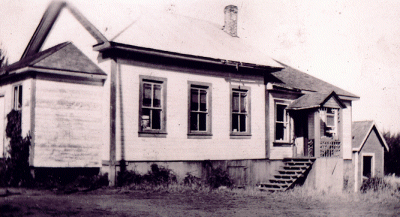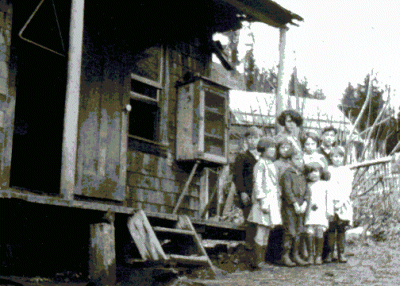Currents of Education: Early Schools in the Discovery Islands, 1894-1929
At the turn of the 20th century, the islands of the Discovery archipelago were attractive to many settlers. Due to the pre-emption system that was in place at the time, there were many opportunities to establish a homestead. From the turn of the century onwards, the islands saw a rise in non-native population, which peaked in the 1920s. Although populations on islands without ferry service have since decreased, there are still visible remnants of the communities that once thrived. Evidence of this can be seen in the abandoned cabins, overgrown logging roads, and old schoolhouses that are still a part of the pristine landscape.
Non-Native Settlement
The Union Steamship Co. was a causative agent in the settlement of the Discovery Islands. The steamships delivered people from various parts of the world, and as a result the communities began to flourish. Often communities would be comprised of a dominant ethnic group. For example, Granite Bay on Quadra Island was primarily a Finnish community and Read Island attracted many American families. Most islanders were dependant on the steamships for transportation to Vancouver Island and the mainland, as well as for the delivery of supplies and mail.
Economic Enterprises
Logging, fishing, trapping, ranching and mining were the chief ways to make a living in these remote areas. Logging was a popular vocation, as it could be undertaken by anyone who claimed land for exclusive timber rights; this was done in a similar way to claiming land for a homestead. Many men practised hand logging, as it was a form of logging that was favourable to the geography of the area. Mining took place on several islands, including Quadra, which opened a small gold and copper mine in 1903. A year later a fish cannery opened on Quadra providing many people with steady employment. The Discovery Islands were bound to the same staples based economy that prevailed throughout the province. As a result, communities were vulnerable to market fluctuations and resource availability. Some islands managed to keep a consistent community whereas others oscillated with economic opportunities.
Isolation
Life was often arduous for the pioneer settlers on these islands. Sea travel was the only mode of connecting with other islands and towns. Most families had a rowboat or a clinker-built boat for travel in the immediate vicinity, but the waterways were rough and fraught with unpredictable tidal currents. Dangerous currents such as "The Hole-in-the-Wall", between the islands of Maurelle and Sonora, prevented easy navigation, and would have intensified the feeling of being isolated.
Establishment of Early Schools
As populations increased in the early 20th century, so did the need for schools and schoolteachers. Communities in need of a teacher were required to elect local school trustees. Once school trustees were elected an application to request a teacher was sent to the Department of Education in Victoria. If the application was approved a schoolteacher was appointed, either by the government or by the local trustees. Time and again the Union Steamship transported young men and women, who had just received their teaching certificates, to the remote regions of the Discovery Islands.
Due to the isolation of these communities the provincial government labelled the schools as 'assisted' rather than 'rural'. This meant that they would fund the teacher's salary, but the schoolhouse was to be the responsibility of the community. Volunteers in the community built the one-room schools. In the 1920s, the cost of materials for these schools was between one hundred and three hundred dollars, but lumber was often donated. An added incentive for community involvement in the building of the school was the fact that it often doubled as a community hall where weekend and evening activities could take place.
Another distinction between assisted schools and rural schools was the number of students necessary to be enrolled in order for the school to continue operating. An assisted school required that only ten students be enrolled for the school year, while a rural school required an enrolment of 20. An assisted school could change its designation to rural if the number of children enrolled in school reached that amount. The locals of these remote regions preferred receiving teachers who had many school-aged children, seeing as the teacher's children would help raise the registration numbers.
Regional Variations
Although economy, geography and transportation were common to all of the Discovery Islands, the schools on each of these islands had unique patterns of development. Looking at four of the islands in the Discovery passage, it is clear that the communities ebbed and flowed at different times, as did their schools. Early schooling may have taken place in whatever buildings were available, but for the purpose of accuracy the dates below refer to the instance when each school was officially defined.
Cortes Island, the southernmost island in the Discovery archipelago, gained the first Cortes Island school in 1902 at Manson's Landing. The European community, which started arriving in 1886, relied on logging and fishing as primary industries. Land on the island was not open for pre-emption until 1893; however, seasonal whaling brought people to the island prior to this date. As the island population grew, Cortes gained three more schools, one in Whaletown in 1911, Squirrel Cove in 1918, and Seaford in 1921.
The earliest school in the Discovery group was the Read Island School established in 1894. This school was located at Evans Bay, which was the site of the first non-Native settlement. By 1893 the community had 60 residents, many of whom were from North Dakota. The settlers did not have enough children to justify the school staying open, and it appears to have closed at the end of the school year. In 1925, the community placed an ad in the Vancouver Province newspaper to encourage more settlers with children. By 1927, there were enough children to warrant a school at Surge Narrows. Contrary to other sources, the annual reports indicate that a school did operate in the years between 1895 and 1927. New sources would have to be uncovered to reconcile these accounts.
Quadra, the largest of the Discovery Islands, was once called Valdes Island. Early explorers mistook the islands of Quadra, Maurelle, and Sonora to be one. This was not corrected until 1903 when each land mass was given their present day names. Due to the considerable size of the island and its geography, communities were isolated from one another. In fact, a road linking the north and south of the island was not built until 1951. Heriot Bay was a central location to acquire supplies, and Heriot Bay school was built there in 1910. In the same year a school called Valdes Island was established at Quathiaski Cove, the site of a salmon cannery. A small Finnish community flourished in Granite Bay on the northwest side of the island. The Granite Bay school opened in 1917 due to the efforts of the many people in the community who donated land, lumber, and labour.
Due to the Okisollo Rapids and Hole-in-the-Wall, Owen Bay of Sonora Island is one of the most difficult communities to access in the Discovery passage. Loggers first settled in Owen Bay, on Sonora Island, in the 1900s, but the majority of settlement took place in the 1920s. Owen Bay school was established in 1927, and for a few years it was located in a floating schoolhouse. As a result of the bay's inaccessibility combined with the island's limited industry, the community never grew to a substantial size.
There are many other islands that make up the Discovery group, and some of them had a large enough community for which to build a school. Maurelle, Stuart, Thurlow, Hardwicke, and West Redonda each acquired schools between the dates of 1913 and 1929. Nevertheless, most of the schools of the Discovery Islands were short-lived as these small coastal communities struggled with fluctuating economies, which forced many residents to relocate.
The Consolidation Era
Starting in the mid 1930s, the Department of Education began consolidating small school districts into larger units. This move to centralize education was followed by reforms to the education system in the 1940s. After the Cameron Commission of 1944, large school districts were created to replace the more regional initiatives. These reforms coupled with a decline in resource-based economies and the cessation of Union Steamship Company services meant that many small community schools in the Discovery Islands could not continue to operate. As a result, many schools in the region did not survive the transition to a more 'modern' educational system.
Cortes Island School (1902)

Cortes Island's first school likely operated from as early as 1895 until 1899 in whatever venues where available. Cortes Island school [left] officially opened in 1902 with Miss Margaret Bonis as the teacher and fifteen students enrolled. Except for a brief closure for the years of 1904-1907, the school managed to keep enrolment high enough to stay open. However, from the school's inception to 1929, there were usually less than twenty students attending the school, designating it an 'assisted' school.
During this time period, teachers rarely lasted longer than one year at the school. The two notable exceptions being Miss K. M. Lettice who served as the teacher during the war years 1914-1918 and Miss Celia Langley who taught from 1926-1930. Out of the sixteen teachers who taught from 1902-1929, twelve where listed as 'miss,' revealing the prevalence of young unmarried women teachers in the province's pioneer schools. Conditions were not very easy for these pioneer teachers, as the turnover rate shows. One teacher in 1928 noted that the supply boat only came twice a week to the island and that there was "little social life" in the community. As Teacher Bureau reports illuminate, the school condition was only "fair" and the teachers' boarding situations were often inadequate. Some of the Cortes Island teachers elected to provide high school classes, but it was left to the teachers' discretion. Cortes Island school continued until the 1940s when it was renamed Manson's Landing school.
Heriot Bay School (1910)

Out of the Discovery Islands, Heriot Bay [above] offered more amenities than any other. As early as the 1890s, Heriot Bay boasted a hotel, store, sawmill and government wharf. Heriot Bay School benefited from the thriving community and easy access to supplies. In the Teacher Bureau reports for the 1920s, teachers working at the school describe the living conditions as "good," which is a marked difference from the "fair" or "inadequate" situations on many of the other Discovery Islands. Contributing to the good living conditions, a three-room accommodation was built on the school grounds for the teacher in 1923. In addition, Heriot Bay School appears to be the only school in the Discovery Group that had a janitor to assist with the school upkeep. Similar to many of the Discovery Island schools, most of Heriot Bay's teachers were young women with second-class teaching certificates.
Owen Bay School (1927)

Owen Bay school [left] was likely the most primitive school in the Discovery Islands. The first teacher at the school, Edith Proctor, noted in the 1928 Teacher Bureau reports that there was a small room for her in the school and that "the school is situated almost on the beach and [had] no cleared playground." Edith also noted that the area is "very isolated few settlers." Interestingly, Edith specifically commented on the fact that Owen Bay was surrounded on all sides by rapids, showing the inaccessibility and remoteness of the community.
The first school in Owen Bay was not in a schoolhouse; rather, it was located in a settler's house. The second school was a fish buyer's building that served as a floating school. The community needed more students to keep the school open so they advertised for a teacher with children. Mrs. Van Der Est and her six children answered the call and swelled the school ranks. Mrs. Van Der Est and her children rowed across the bay to school every day. The wind came into the classroom from cracks in the walls and water would flood the room during high spring tides. For a while the school had only three families attending it, one of which was the teacher's. In 1944 a second school was built and this schoolhouse is currently a residence in the sparsely populated community of Owen Bay.
Sources:
British Columbia Archives: MS-0355, Sweetnam, Patience; Owen Bay Annual Report; British Columbia Archives. Department of Education. Teacher Bureau Reports, GR 461 box 1, files 4, 2 and box 2 files 3, 5, 8, 9; Joan Adams and Becky Thomas, Floating Schools and Frozen Inkwells, (Madeira Park, B.C.: Harbour Publishing, 1985); British Columbia. Department of Education, Annual Reports, 1916-1918, 1919-1923, 1923-27, 1927-31; Liv Kennedy, Coastal Villages Madeira Park, BC: Harbour Publishing, 1991; Taylor and Douglas, Exploring Quadra Island Quathiaski Cove, B.C.: Fernbank Publishing, 2001; Barbara Ann Lambert, Chalkdust & Outhouses: West Coast Schools, 1893-1950, (Powell River, B.C.: Author, 2000); Patrick A. Dunae, The School Record: A Guide to Government Archives Relating to Public Education in British Columbia 1853-1946, (Victoria: Ministry of Government Services, 1992).
Researched and written by Sarah Garcia and Tracey Moss, History 349, Malaspina University-College, March 2003.

